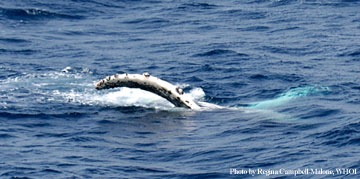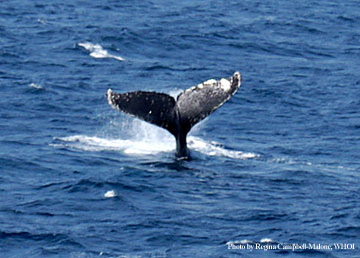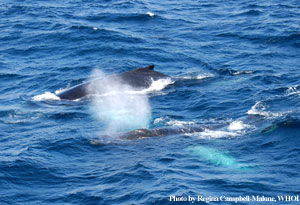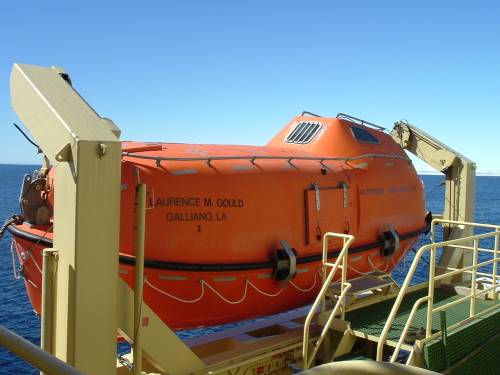[Wind: WSW 25kn / Air Temp: 2.5C / Wind Chill: -?C /Seas 1-2 ft]
| • Home |
| • Questions |
| • Participants |
| • Background Information |

| 1 | 2 | 3 | 4 | 5 | 6 | |
| 7 | 8 | 9 | 10 | 11 | 12 | 13 |
| 14 | 15 | 16 | 17 | 18 | 19 | 20 |
| 21 | 22 | 23 | 24 | 25 | 26 | 27 |
| 28 | 29 | 30 |
| 1 | 2 | 3 | 4 | |||
| 5 | 6 | 7 | 8 | 9 | 10 | 11 |
| 12 | 13 | 14 | 15 | 16 | 17 | 18 |
| 19 | 20 | 21 | 22 | 23 | 24 | 25 |
| 26 | 27 | 28 | 29 | 30 | 31 |
Another lovely day in iceberg paradise. It was James Bellanger’s birthday (alas, perhaps a …cake??). James is one of the mates who steers this vessel. It’s a blue water, blue sky kind of day and there was nothing remarkable beyond that, until… the call came from the Bridge that whales had been sighted. Well, you never saw such a rush from microscope, from jelly-watching, from food and from rest, to grab cameras and head for the decks to see what James was seeing!
It turned out to be a pair of humpback whales, one larger than the other (but both were pretty big!), just dallying out there in front of the ship! They hung out at the top of the water, blowing every couple of minutes, and rolling over, seemingly playing with, and touching one another. At one point, there was some rust-colored change in the water around them. Our resident whale expert, Regina Campbell-Malone, reports this was probably some sort of …throw-up thing that whales do. What we were seeing was ‘recycled krill’. She explains, “One thing I didn't get a photograph of was something that came out of one whale's mouth when it was quite far away. I think it was ambergris (commonly known as smelly, oily, floating whale barf!?!). Ambergris from sperm whales was once used as an ingredient in fine perfumes and colognes.”
James slowed the boat way down so we could watch for about 20 minutes. The whales did their thing, rolling and occasionally diving (nice flukes!), but generally staying near the boat and checking us out – until we left them!
Regina described some physical characteristics of interest: “One image I have shows the pectoral fin of the smaller whale. You can see the bumps (called tubercles) on the trailing edge of the fin. They make the whale’s flipper glide through the water so efficiently that aerospace engineers (airplane designers) are looking into adding them to the wing design of new jets!” [See Images 1 - 3] It was very exciting - they are such magnificent animals.
Speaking of excitement, we had a fire drill the other day, and that really gets your heart beating! I guess the ship’s required to have one once a week, and so far I’ve been fortunate to have them happen when I was up and about. (Being blown out of your sleep is not a happy thing, but there’s always somebody sleeping, so my turn is probably coming…). The bell is really loud, and you can hear it anywhere. What you’re supposed to do is STOP WHAT YOU’RE DOING and go to your stateroom. There is a life jacket and a water Survival suit for each person, and that’s where they’re kept. You grab your two life saving items, and anything like warm clothes that is right nearby, and in the case of the drills, head for the Main Lounge. When the person who called the drill (Skip Owen) feels enough time has been given (like, 2 minutes), he takes roll call. If you don’t have a note from home, you’d better not come late!! These drills are taken very seriously, and everyone must know the drill. We’d already done the drill of putting on the Survival Suits, so we don’t do that each time, but if we needed to, we’d get right into them and get to the top deck, ready to board the Life Boats. [See Image 4]
Two more weeks, two more drills to go…
Captions (Regina’s photos) Image 2-- This is the tail of one of the humpbacks that we saw today! The whales swam together and stayed around the boat rubbing one another and swimming belly up for more than 15 minutes. [Photo by Regina Campbell-Malone] Image 3-- This image captures a pair of humpback whales surfacing, while a nearby Cape Petrel gets hit with whale blow!

Photo3

Photo4

From high up on ship's deck, we could see the whale's white pectoral fins even when the whale was 5-10 feet underwater! [Photo by Regina Campbell-Malone] Image 1-- Belly Up! The whales flipped over often as they swam together. They swam belly up side by side and stroked one another with their pectoral flippers. This picture shows one of the humpbacks belly up with it's right pectoral flipper visible out of the water (the left on is submerged). You can see the bumps (called tubercles) on the trailing edge of the fin. It is thought that they make the flipper glide through the water more efficiently! [Photo by Regina Campbell-Malone]
Dinner Menu (shipboard, 12/9): | |
TBD |